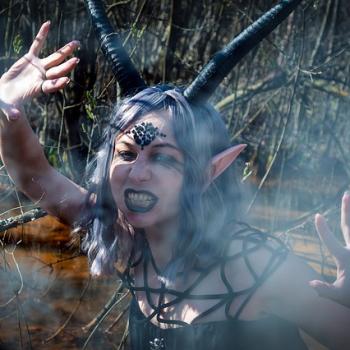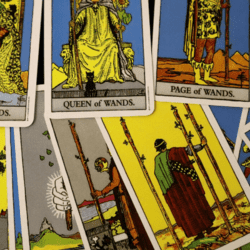There is no figure in modern Heathenry and related traditions that is as controversial as Loki. This makes sense given his very nature; all of the stories about him he present us with a wild mix of attributes. Many hate and fear him, many love him (and many of those still fear him) and many are adamantly, staunchly indifferent to him, a state of things that reflects well our many understandings of Loki Laufeyson.
I am including him as the third in my series of Divine Profiles, because regardless of what may have been in the past he is undoubtedly a popular figure, a widely-worshiped God, and one who draws many to the practice of revering the Northern Powers in modern times.
Lore
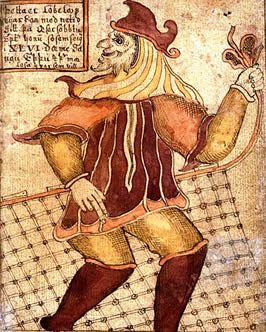
Loki is a regular character in the Eddas (some would say he’s a regular “character” anywhere he happens to be). He’s the child of giants but in places is numbered among the Aesir Gods. He’s the blood-brother of Odhinn, and by oath where one drinks another must be allowed to. He’s spoken of by Snorri in the Gylfaginning thusly:
“Also numbered among the Æsir is he whom some call the mischief-monger of the Æsir, and the first father of falsehoods, and blemish of all gods and men: he is named Loki or Loptr, son of Fárbauti the giant; his mother was Laufey or Nál; his brothers are Býleistr and Helblindi. Loki is beautiful and comely to look upon, evil in spirit., very fickle in habit. He surpassed other men in that wisdom which is called ‘sleight,’ and had artifices for all occasions; he would ever bring the Æsir into great hardships, and then get them out with crafty counsel. His wife was called Sigyn, their son Nari or Narfi.”
Ouch. Hardly sounds complimentary, other than the “beautiful and comely to look upon.” He goes on to say:
“Yet more children had Loki. Angrboda was the name of a certain giantess in Jötunheim, with whom Loki gat three children: one was Fenris-Wolf, the second Jörmungandr–that is the Midgard Serpent,–the third is Hel. But when the gods learned that this kindred was nourished in Jötunheim, and when the gods perceived by prophecy that from this kindred great misfortune should befall them; and since it seemed to all that there was great prospect of ill–(first from the mother’s blood, and yet worse from the father’s)-then Allfather sent gods thither to take the children and bring them to him. When they came to him, straightway he cast the serpent into the deep sea, where he lies about all the land; and this serpent grew so greatly that he lies in the midst of the ocean encompassing all the land, and bites upon his own tail. Hel he cast into Niflheim, and gave to her power over nine worlds, to apportion all abodes among those that were sent to her: that is, men dead of sickness or of old age… She is half blue-black and half flesh-color (by which she is easily recognized), and very lowering and fierce.”
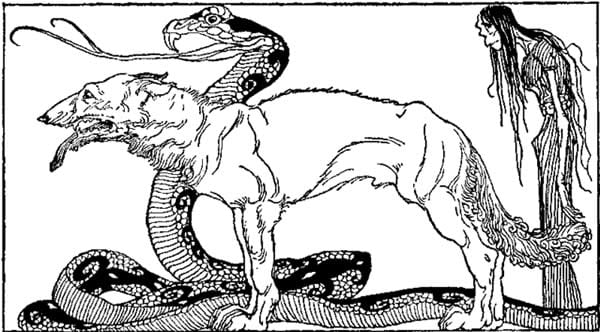
So many of his children in the lore are dire beings as well. Two of them are involved in the fall of the Gods at Ragnarok. The third, Hel, is honored by many and in some ways far less controversial than her father, but still a dread figure in her own right.
Loki has other children. Slepinir, Odin’s eight-legged horse is counted among them. Early after the establishment of Asgard, a giant came by who offered to build a powerful wall around it, strong enough to keep out the Giants. He didn’t ask for much – just the sun and the moon, and Freyja (they always ask for Freyja as though She’d go off to marry any man She didn’t want to!). They told the giant that if he completed his edifice before the first day of summer, he would get nothing, but if he did have it done before summer’s beginning he would get what he asked for. The giant asked for the aid of his stallion, which was the cause of much disagreement, but because Loki advised the Gods to let him keep his stallion, he was allowed to.
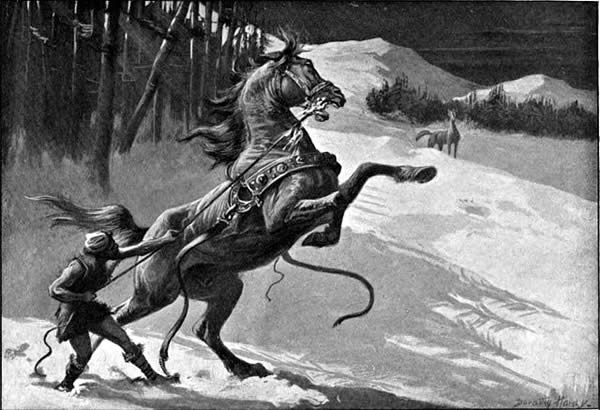
At three days to summer it seemed that the mason would have his job completed in time, and the Gods were none too happy with Loki for his advice. They threatened him, and in return he swore to make sure the giant failed at his task. Loki took the form of a lovely mare and lead the stallion away for dalliances on these three days. Without his horse the giant could not fulfill his end of the bargain (for which Thor crushed his head, like you do) and Loki walked away pregnant with the magical, wonderful octopoid Sleipnir who carries the All Father through all of the Nine Worlds.
Loki has more stories than I can share here – he held a contest that lead to the Gods getting some of their finest tools; he was responsible for the death of Baldur, Odin’s son; he dressed as Freyja’s maid while Thor dressed as the Lady Herself to retrieve Mjorlnir from the giant Thrym; he stole Freyja’s necklace Brisingamen and had Heimdall chase him down, ending in an epic fight in seal-form, he retrieved Idunna’s apples of immortality from the giant Thiazi; he has an epic adventure with Thor in Jotunheim… quite a mixed career, our Loki has had.
Lokasenna is a poem in the Elder Edda (most recently the subject of a beautiful, intense, and cathartic theatrical ritual put on by the Golden Gate Kindred at PantheaCon), where the Gods have gone to have a party in the giant Aegir’s hall beneath the waves. Loki is not invited but shows up anyway, invoking Odhinn’s oath to allow him to drink wherever he drinks. He proceeds to roast the Gods, calling them out (as they do to him in return) and for his poor hospitality is dragged off. His children are eviscerated and with their intestines he is bound to a rock with a serpent positioned above him, its venom dripping constantly into his eyes. His wife Sigrun carries a bowl to catch the venom, but when she goes to empty it he writhes in pain, causing earthquakes. The stories about Loki rarely end easily, and the Northern peoples took their hospitality seriously.

Heiti or Bynames

Loki also has several heiti or bynames. The only one that I’ve been able to find referenced in the lore is Loptr, which means “high-flying” or “aloft” (although some people translate it as Skywalker, I feel that that is more likely a figurative translation and a joke about “Loki Skywalker” than a solid literal translation. I honestly do not know for sure.)
What is fascinating is that there has been scholarly debate as to whether the Lodhur mentioned in the Eddas is the same as Loki. As one of the three creators of humanity (the one who gave them “blood” or “goodly hue”) it would certainly cast him in a new light.
There are many, many modern heiti for him. Laufeyson, Flamehair, Heimdall’s Bane, Bound God, World-Breaker, Trickster… they are as common as blogs devoted to him on Tumblr. One of my favorites, coined by my friend River, is “The Helpingest Helper”, a commentary on his standard style of assistance. Another friend, Lauren, refers to Loki as the “Lord of Butthurt” in reference to not only his angst but the conflict that surrounds the very mention of his name.
Gnosis
There is a lot of modern gnosis revolving around Loki. Though many feel that worship of him is inappropriate for a wide variety of reasons, that hasn’t stopped a vast and rich following from emerging. Many are attracted to him; he is clever, well-spoken, uses his wits and magick to overcome problems, and is a liminal trickster-type figure in our mythology.
In modern times he’s come to be associated with fire (perhaps due to conflation with the fire spirit Loge), but at this point the association has firmly embedded itself in modern belief and practice. Common animal associations include foxes, spiders and other animals that are associated with trickster figures.
Many people honor him as a God of outsiders and outcast. There is a view of him as an underdog given his place in the lore, and there is something to that view. No matter what good he brings, ill is expected of him, so when it does follow in his wake no one is surprised. For those of us who have lived lives marginalized by mainstream society there is an appeal to a God who has experienced and survived the mistreatment of those who hold authority in that society. Worship of Loki can be raising a big middle finger to established power structures and dominant and oppressive mores; after all, at the end of things he helps to tear down the structures the Gods have so carefully built.
He is acknowledged by some as a God of necessary change, who brings about destruction that is needed. Rather than binding or imprisoning things he sets them free through magick, trickery, and flame. Rather than pretend to know who he is he changes constantly, and acts as a mirror to force folks to confront the uncomfortable truths that they do not want to see about themselves. “Comfort the disturbed and disturb the comfortable.” could very well be a motto of his.
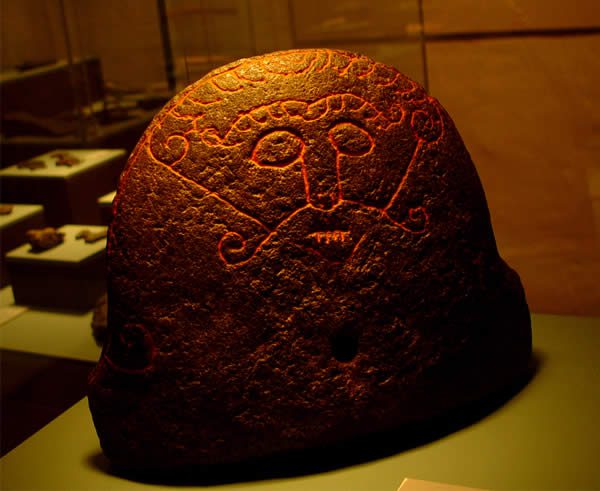
As I’ve said, there are many who feel that offering to Loki is inappropriate for a variety of reasons. He is named a kin-slayer (though not the only one in our stories), a giant (though there are many giants that we do honor), a source of chaos (that cannot be argued, but again, change is sometimes needed). There are those who refuse to speak his name or spit upon the ground when they hear it. As I understand it these beliefs are more common in American Heathen practice than in the European forms of the old faiths; there has been the suggestion that people converting from faiths with a source of absolute evil do not feel comfortable adapting a new one without assigning that role to a member of the pantheon, and he’s the most likely candidate.
My personal gnosis in working with him: To me he feels like the wolf stalking around the edge of the campfire, yellow eyes glinting in the dark. He keeps you on edge, and though he may never come closer, the awareness he brings protects you from things that really pose a threat to you. His masks are never what his intentions are, and it’s never as simple as a binary good-and-bad with him. He is the transforming flame, the sudden shift that opens your eyes, makes your spine straight and your fingertips tingle. He speaks lies with his mouth while he is working the truth with his hands. He knows pain, oh he knows pain and bitterness so well, and when I need divine commiseration it is to him I go to; he gives me sympathy there when other Gods would demand action that I will not or cannot perform. He knows the pain, and he hands me a piece of the burnt Heidh’s heart to eat. Most of all, he is the endless series of masks that keep slipping away, as he asks over and over, “What am I?” and each answer changes his face to something that is not that.
Resources
There are quite a few books out about Mr. Popular. It’s hard to say which ones are definitive or Lore-appropriate because we have a limited set of information about him in the Lore.
I’d like to recommend Silence Maestas‘ new book, “Worshiping Loki”. It’s a good one to help you with establishing a devotional practice with Loptr, and unique in that the practice that it suggests is not Heathen-specific. He has created a book about connecting with the God, whether or not you are a practicing Heathen of any variety.
I enjoyed reading “Beyond Reason” by Heather Freysdottir, her journal of her love affair with Loki. She is a Godspouse (her devotional relationship with him follows the pattern of a marriage; she is married to him) of Loki and has a deep and powerful love for him. It’s a book filled with strange beauty and beautiful strangeness.
A book on my to-read list that has been recommended by many is Playing With Fire: An Exploration of Loki Laufeyjarson by Dagulf Loptson. Dagulf has also written a series of articles about him on Polytheist.com.
In addition, here is an excellent article by John T. Mainer of the Troth, where he discusses his feelings on Loki’s Kids (those who feel chosen by or have special devotional relationships with Loki).
Here is a song that I am quite convinced* is about him. They pronounce his name oddly, though. Perhaps it’s a regional dialect.
I am sure that there are many others. As I always recommend, look to the Lore first, read about him in the Eddas. Read Loka Tattur, a Faroese ballad where he plays the hero. If you’re brave, reach out to him, honor him, and see what comes of it. It probably won’t be comfortable, it won’t make you popular in conservative Heathen circles, and he might not be a God you resonate with – but then again, he might be. You won’t know if you don’t try, and you may learn that his fell reputation is not representative of the power that he is.
*I am as convinced of this as I am that writing this article was a good idea.

Patheos Pagan on Facebook.
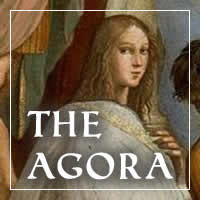
the Agora on Facebook
The Lady’s Quill is published on the second and fourth Thursday of every month. You can subscribe by RSS and e-mail.
Please use the links to the right to keep on top of activities here on the Agora as well as across the entire Patheos Pagan channel.










